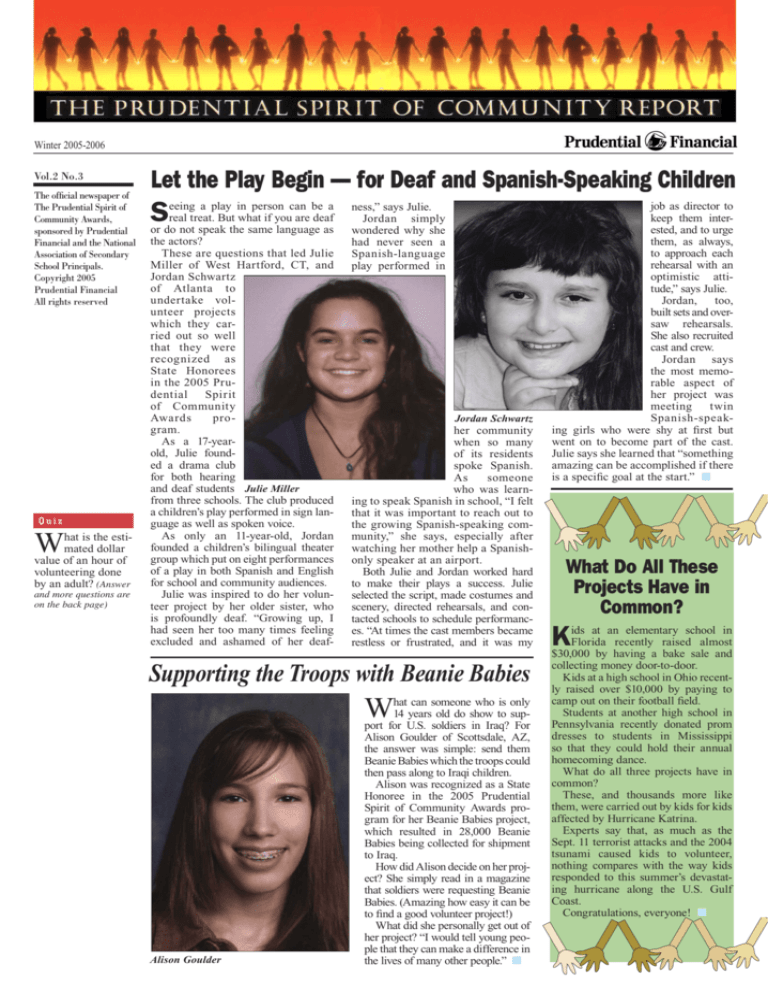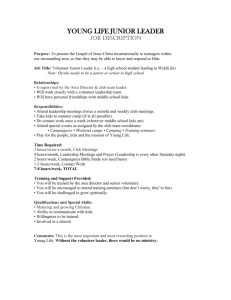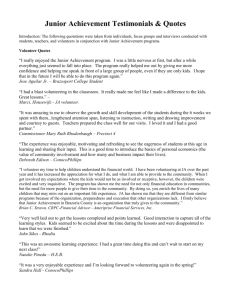
Winter 2005-2006
Vol.2 No.3
The official newspaper of
The Prudential Spirit of
Community Awards,
sponsored by Prudential
Financial and the National
Association of Secondary
School Principals.
Copyright 2005
Prudential Financial
All rights reserved
Quiz
W
hat is the estimated dollar
value of an hour of
volunteering done
by an adult? (Answer
and more questions are
on the back page)
Let the Play Begin — for Deaf and Spanish-Speaking Children
S
eeing a play in person can be a
real treat. But what if you are deaf
or do not speak the same language as
the actors?
These are questions that led Julie
Miller of West Hartford, CT, and
Jordan Schwartz
of Atlanta to
undertake volunteer projects
which they carried out so well
that they were
recognized as
State Honorees
in the 2005 Prudential Spirit
of Community
Awards
program.
As a 17-yearold, Julie founded a drama club
for both hearing
and deaf students Julie Miller
from three schools. The club produced
a children’s play performed in sign language as well as spoken voice.
As only an 11-year-old, Jordan
founded a children’s bilingual theater
group which put on eight performances
of a play in both Spanish and English
for school and community audiences.
Julie was inspired to do her volunteer project by her older sister, who
is profoundly deaf. “Growing up, I
had seen her too many times feeling
excluded and ashamed of her deaf-
ness,” says Julie.
Jordan simply
wondered why she
had never seen a
Spanish-language
play performed in
Jordan Schwartz
her community
when so many
of its residents
spoke Spanish.
As
someone
who was learning to speak Spanish in school, “I felt
that it was important to reach out to
the growing Spanish-speaking community,” she says, especially after
watching her mother help a Spanishonly speaker at an airport.
Both Julie and Jordan worked hard
to make their plays a success. Julie
selected the script, made costumes and
scenery, directed rehearsals, and contacted schools to schedule performances. “At times the cast members became
restless or frustrated, and it was my
Supporting the Troops with Beanie Babies
W
Alison Goulder
hat can someone who is only
14 years old do show to support for U.S. soldiers in Iraq? For
Alison Goulder of Scottsdale, AZ,
the answer was simple: send them
Beanie Babies which the troops could
then pass along to Iraqi children.
Alison was recognized as a State
Honoree in the 2005 Prudential
Spirit of Community Awards program for her Beanie Babies project,
which resulted in 28,000 Beanie
Babies being collected for shipment
to Iraq.
How did Alison decide on her project? She simply read in a magazine
that soldiers were requesting Beanie
Babies. (Amazing how easy it can be
to find a good volunteer project!)
What did she personally get out of
her project? “I would tell young people that they can make a difference in
the lives of many other people.” ■
job as director to
keep them interested, and to urge
them, as always,
to approach each
rehearsal with an
optimistic attitude,” says Julie.
Jordan, too,
built sets and oversaw rehearsals.
She also recruited
cast and crew.
Jordan says
the most memorable aspect of
her project was
meeting twin
Spanish-speaking girls who were shy at first but
went on to become part of the cast.
Julie says she learned that “something
amazing can be accomplished if there
is a specific goal at the start.” ■
What Do All These
Projects Have in
Common?
K
ids at an elementary school in
Florida recently raised almost
$30,000 by having a bake sale and
collecting money door-to-door.
Kids at a high school in Ohio recently raised over $10,000 by paying to
camp out on their football field.
Students at another high school in
Pennsylvania recently donated prom
dresses to students in Mississippi
so that they could hold their annual
homecoming dance.
What do all three projects have in
common?
These, and thousands more like
them, were carried out by kids for kids
affected by Hurricane Katrina.
Experts say that, as much as the
Sept. 11 terrorist attacks and the 2004
tsunami caused kids to volunteer,
nothing compares with the way kids
responded to this summer’s devastating hurricane along the U.S. Gulf
Coast.
Congratulations, everyone! ■
Helpers Around the World
T
hough only 14, David Woodbury of San Juan, PR is as
valuable as any adult at the small
hospital where he volunteers. The
“Adopted children should be
aware of their backgrounds and
pital. Says David, “It took me a heritages and see that they are
not
the
while to get used to
only chilthe kids, but once I
dren adoptdid, it was just like
ed
from
talking to normal
Korea,” she
kids.”
says.
David also says,
As
the
“Even though they
group’s new
(the kids in the hoscoordinator,
pital) might not have
Amanda
the abilities that we
has orgahave, they should
nized meetstill have the friends
ings, sent
that we have,” which
out a newsis why David plays
letter, and
with the patients on
helped other
a regular basis.
members in
their adopthen Amanda
ed
land.
Pourciau of
Amanda
Pourciau
“Being an
New Orleans, LA
i nt e r r a c i a l
was adopted from
Korea, her new parents were mem- adoptee can make one feel isolatbers of a support group for families ed and alone,” she says, a problem
with adopted Korean children. As Amanda works to prevent.
time went on, the group became
any Hispanic immigrant chilinactive, but after having a chance
dren live in Phoenix, AZ and
to learn about her roots on a trip
to Korea, Amanda took it upon Charles Strauber has done his best
herself to revitalize the support to teach them English as a volunteer at a local elementary school.
group.
W
David Woodbury
hospital is for mentally and physically challenged kids, and David’s
time is spent playing with the kids,
raising money for the facility, and
helping out in many other ways.
David was inspired to become
a volunteer by his science teacher,
who also volunteers at this hos-
T
here is a
new national monument
in Washington,
DC and, unlike
DC’s other monuments dedicated to great
American Presidents, this one
honors America’s great volunteers. Plans call for
up to 70 people to be honored along a
mile-long stretch of sidewalk near the
White House. T h is fall the f i rst 20
honorees had thei r l i kenesses cast
i n bron ze a nd embedded i n the side wal k , along w ith a br ief biog raphy of
each. T he f i rst 20 honorees i nclude :
Wi l l iam D. Boyce, fou nder of the Boy
Scouts of A mer ica ; Wi l l iam Edw i n
Hal l, fou nder of Boys & Gi rls Clubs
of A mer ica ; Mar t i n Luther K i ng, the
civ il r ig hts leader, a nd Er nest Kent
Cou lter, fou nder of Big Brothers / Big
Sisters of A mer ica.
❖ W h i le k i d s l i ke t o vo lu nt e e r
for a l l k i nds of wor thwh i le ac t iv i t ie s, few a ct iv it ies at t r a ct a s much
i nt e rest a s cr i me and d r ug preven t ion prog rams . Accord i ng t o a rece nt
p ol l, a l most n i ne out of 10 te enager s
wou ld volu nte er t o t a ke pa r t i n such
prog r a m s i f they k new how to get
i nvolve d.
❖ Volunteering k nows no national
boundaries. When a devastating earthquake recently struck the mountainous
region of Pakistan, Pakistanis living
in the United States went straight to
work. According to news reports, one
M
group of Pakistanis near Seattle, WA
collected sleeping bags, tents and clothing for the survivors. In California, a
group of Pakistani-American doctors
arranged fund-raising dinners. Another
California-based group has pledged to
raise $1 million for relief efforts. ■
10
5
2
8
A
Charles Strauber
“I relish the feeling I get when
I see students’ faces light up with
understanding,” says Charles,
who tutored about 30 students
individually in both reading and
math.
Based on the progress he saw
with the kids, Charles also organized an English program for
Hispanics of all ages at a local
library. Being able to speak English will make these immigrants
“one hundred more times prepared
to adjust to American culture and
to succeed here,” he says. ■
Did You Know...
ccording to a recent poll, more than
four out of five college students in the
United States believe that community volunteerism is an effective way to solve important issues facing their country. ■
7
3
9
6
4
1
R
esearch from the Points of Light
Foundation and university researchers
shows Utah as the state with the highest rate of volunteering, followed by, in
order: Nebraska, Iowa, Minnesota and North
Dakota. The state with the lowest rate of
volunteering is Nevada, followed by, in order:
Louisiana, Rhode Island, New York and West
Virginia. Can you find each of these 10
states on the numbered map? (Answers are
on back page)
Helping Senior Citizens Motivates Each of These Kids
T
hey come from different
states, but they share a commitment to helping senior citizens.
Meet Cormac O’Connor of
Kansas, Emily Felix of Massachusetts, Delaney Sweeney of
Missouri and Jacob Hillman of
Utah, all State Honorees in the
2005 Prudential Spirit of Community Awards program.
Each of these kids does an activity that is popular with young volunteers across America. As you
Cormac O’Connor
will see when you read the story Jacob visits and performs a varion this page about the 10-year ety of household chores for local
history of the Prudential Spirit senior citizens — simple things
of Community Awards program, that most people take for grant“reaching out to senior citizens” ed but which can be difficult for
was the sixth most popular volunteer activity
for the more than 1,000
kids who have been recognized as State Honorees.
When he was only
12, Cormac put together an arts program for
senior citizens and
at-risk children. As
a 15-year-old, Emily
created a youth volunteer group that
provides senior citizens with companionship, assistance
with chores, and
financial aid to help Delaney Sweeney
with the high cost of
prescription medicines.
Delaney created a “Grandkids Club” when she was 13.
The club arranges monthly
visits by kids to a local nursing home, where they do
games and crafts with elderly
residents. Fourteen-year-old
10-Year Survey of Prudential Honorees
Shows Many Help Sick, Disadvantaged
S
ince it began in 1995, nearly 200,000 young people in
the United States have participated in the Prudential Spirit
of Community Awards program.
Of those, 1,040 have been recognized as State Honorees, and
of those 1,040, more than 22%
took on a volunteer project that
helped or comforted the sick or
disabled.
But while helping people who
are sick or disabled has been the
most popular activity of Prudential State Honorees, coming in a
close second was aiding the disadvantaged and helping the hungry. Approximately 20% were
honored for these activities.
While no other activity came
close to matching these two
frontrunners, State Honorees
have performed a wide variety of
volunteer projects.
Coming in third place, at 10%,
was the category “enhancing
school or community resources,”
followed close behind by a similar
category: “teaching, tutoring or
mentoring other young people.”
After that came such worthwhile activities as: reaching out
to senior citizens; spreading the
spirit of volunteerism; protecting
the environment; and addressing
needs in other countries.
The survey also found that
kids were most likely to succeed
in their volunteer projects when
they chose something they were
interested in, when they recruited
friends and family members to
help, and when they sought out
advice and guidance.
So how can any kid get started
on a worthwhile volunteer project?
The survey suggests that firsthand experience is the best guide.
Indeed, kids who had experienced
a personal crisis such an illness,
or had seen others who needed
help, got involved in highly successful projects. ■
senior citizens, tasks such as feeding pets and taking out garbage.
Cormac got inspired to do his
arts program after seeing how
well young and old people worked
together on a neighborhood play-
Emily Felix
ground project. Emily’s inspiration was her neighbor’s
mother-in-law, who didn’t
have enough money for all
of her prescription medicines.
Delaney’s grandfather was
her inspiration. After visiting
him in a nursing home, she
started her club. Like Emily,
Jacob got involved because of
a neighbor, a woman who simply was very old and lonely.
As you can see, there is
inspiration for a great volunteer project on every corner of
every neighborhood! ■
Jacob Hillman
D
Helping the Homeless,
One Meal at a Time
o you know of a park, street
corner or other place where
homeless people congregate?
Marcus Binns does. After
Marcus participated in a churchsponsored program to help feed
Marcus Binns
homeless people, he started his
own program for people in his
community of Bryant, AR.
“I felt it was important to reach
out to the people everyone avoided
and looked down upon and to help
them,” says Marcus, whose program earned him recognition as a
State Honoree in the 2005 Prudential Spirit of Community Awards
program.
Through Marcus’s program,
homeless people receive food and
supplies every Sunday afternoon.
Marcus and other members of his
church youth group set up a picnic
table and hand out sandwiches,
drinks, etc.
“I do this service for the smile
I receive when I hand someone a
sandwich,” says Marcus. “It amazes me to see someone so excited
over something so small.” ■
In Their Own Words
“I
got bored in the hospital, so my mom
brought me
some crafty things
to do.” Thus began
Amanda
Pittmon’s volunteer
activity: making
jewelry for local
hospital patients.
“I would load
up my IV pole Amanda Pittmon
Computer Corner
(Another in series about kids recognized
by the Prudential Spirit of Community
Awards program for computer-related
projects.)
A
fter Maryland eighth-grader AbdulMoneim Sallam learned about
Internet Safety through a program organized by I-SAFE America, he set about
raising community awareness of the
risks of being online.
The result was the first-ever Internet safety week at his school. Activities
included an Internet safety lunch information table where kids got prizes for knowing Internet safety facts. He also had a
poster contest, with kids submitting work
on such topics as cyber dating, cyber bullying, rumor sites and identity theft.
Abdul-Moneim also held a parents’
night and a “professional development”
day for over 50 Maryland educators.
“Internet safety isn’t taught in schools,” he
explains. “In addition, since parents never
had the same online experience as kids,
they don’t really know about the risks.”
Abdul-Moneim is a spokesman for ISAFE and now goes to other schools to
warn kids about the dangers of the Internet. Among the points he makes: “Don’t
give out identifying information.” ■
Map Answers
1. Louisiana
2. Utah
3. Minnesota
4. W. Virginia
T
5. Nevada
6. Iowa
7. New York
8. Nebraska
9. Rhode Island
10. N. Dakota
with the bracelets, necklaces and key
chains and deliver them to as many
rooms as possible.”
Amanda, who has had numerous surgeries for congenital physical problems,
donates any money people give her to
“Water for Life,” a group that provides
clean drinking water for children in
Africa. “I can do something to make
a difference and to let people know
that I care,” says Amanda, who lives in
Bossier City, LA.
“I
have had Type 1 diabetes since I
was six. Even then I knew I wanted
three things: to be cured, for no other
kids to ever have to be diagnosed as I
was, and for people to understand my
disease.”
And so Lauren Stanford of Plymouth, MA organized family and friends
into “Lauren’s
League for the
Cure,” a group
that raises money
for research and
educates people
about Type 1 diabetes.
Lauren’s group
has raised over
Lauren Stanford
$200,000 by participating in walkathons
and other events. She also convinced the
head of a major corporation to write
a check for $250,000 more! She has
spoken to many groups, including the
Massachusetts legislature.
“D
ue to language and cultural barriers, news of programs that could
have helped my mother learn English,
and pay for my prenatal care and family
health care, never reached my family,”
says Jeffrey Kwong of San Francisco,
explaining why
he has for many
years volunteered
as a caseworker
and translator
helping local Chinese residents.
Jeffrey translates documents,
Jeffrey Kwong
answers
telephone calls, and personally works on
a wide variety of problems that people
have which local government officials
can address.
He also goes to community and
municipal meetings, translating for
Chinese families, thereby giving them
a true voice in their community. ■
Quiz Continued from Page One
Quiz Answer: The estimated dollar value of an hour of volunteering done by
an adult is a little over $17.
1. Among Americans age
16 and older, what percentage volunteered in
2003:
a. 3.3%
b. 14.9%
c. 28.8%
d. 44.1%
2. Approximately how many
volunteers responded to
the series of hurricanes
that ripped across Florida
in 2004:
a. 22,000
b. 67,000
c. 140,000
d. 900,000
3. One reason why the number of volunteer firefight-
ers in the United States
is declining is all the
training they must now
have. Most volunteer fire
departments want recruits
to have how many hours
of initial instruction:
a. 5
b. 50
c. 70
d. 100
4. Which state is the only
one that requires students
to perform a certain number of volunteer hours in
order to graduate from
high school:
a. Maryland
b. California
c. Wisconsin
he Prudential Spirit of Community Awards constitute the
nation’s largest youth recognition program based exclusively
on volunteer community service. Since its inception in 1995, the
program has honored more than 60,000 middle and high school
students at the local, state and national level. Applications are
available each fall through schools, Girl Scout councils, county
4-H programs, Red Cross chapters, YMCAs and Volunteer Centers affiliated with the Points of Light Foundation. For more
information, visit www.prudential.com/spirit or www.principals.org,
or call 1-888-450-9961.
d. Florida
5. What percentage of adult
volunteers also volunteered
when they were kids:
a. 40%
b. 67%
c. 88%
d. 100%
6. Back in 1989, 66% of
college freshmen said
they had volunteered during their senior year of
high school. In 2004 that
figure was:
a. 33%
b. 61%
c. 83%
d. 95%
Answers: 1. c; 2. c; 3. d; 4. a; 5. b; 6. c
(In each issue we let kids speak for themselves on why they volunteer and why
they chose the projects they did. Each of
these kids is a 2005 Prudential Spirit of
Community State Honoree.)
The Prudential Spirit of Community Report
is the official newspaper of The Prudential
Spirit of Community Awards program. It is
published online by Prudential Financial,
in cooperation with Earth Preservers Inc. of
Westfield, NJ. (908) 654 9293. Copyright
2004-2006 Prudential Financial. All Rights
Reserved. The Prudential Spirit of Community Report can be downloaded or reproduced for free.
Publisher—Scott Peterson
Editor —Bill Paul
Art Director—Alice Kenny
Production Ass’t—Sylvia Rosado









